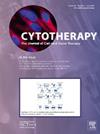A survey of cell processing practices for hematopoietic cell transplantation
IF 3.7
3区 医学
Q2 BIOTECHNOLOGY & APPLIED MICROBIOLOGY
引用次数: 0
Abstract
Background
There is considerable heterogeneity in cell handling practices for hematopoietic stem cell transplantation in cell processing centers in Spain. The European Directorate for the Quality of Medicines and international standards are not intended to establish best practices or to include all procedures; therefore, each cell processing laboratory must define its own practices and procedures.
Methods
A survey was conducted to better understand the differences among cell processing laboratories in Spain in terms of type of facilities and equipment available, service portfolio, staff, informatics systems, product handling, environmental and product quality control tests, batch release criteria, storage and shipping conditions, and criteria for product disposal or recall, to identify areas for harmonization.
Results
In this study, 31 authorized centers responded to the survey. Fifteen centers do not usually wash cryopreserved grafts, in contrast to others that perform washing systematically (n = 5) or when the product contains >1 g/kg/dimethyl sulfoxide or recipient body weight is <25 kg (n = 11). We observed high variability in terms of handling of thawed samples, such as in protocols used to enumerate CD34+ cells, compensation solution, temperature and time delay between thawing and CD34+ enumeration. Storage time for cell therapy products varied between 5 and 30 years. Additionally, 12 centers do not reduce plasma before cryopreservation to save space.
Discussion
Overall, this survey demonstrates variability in activity, logistics and staff among cell processing laboratories in Spain. Some issues remain ongoing and further efforts should be undertaken to harmonize practices in these facilities, such as indications and procedures for washing cryopreserved stem cells and handling of cryovials to enumerate viable CD34+ cells after thawing. Efforts are needed to regulate product storage to optimize space utilization and reduce associated costs.
造血细胞移植的细胞处理方法调查。
本文章由计算机程序翻译,如有差异,请以英文原文为准。
求助全文
约1分钟内获得全文
求助全文
来源期刊

Cytotherapy
医学-生物工程与应用微生物
CiteScore
6.30
自引率
4.40%
发文量
683
审稿时长
49 days
期刊介绍:
The journal brings readers the latest developments in the fast moving field of cellular therapy in man. This includes cell therapy for cancer, immune disorders, inherited diseases, tissue repair and regenerative medicine. The journal covers the science, translational development and treatment with variety of cell types including hematopoietic stem cells, immune cells (dendritic cells, NK, cells, T cells, antigen presenting cells) mesenchymal stromal cells, adipose cells, nerve, muscle, vascular and endothelial cells, and induced pluripotential stem cells. We also welcome manuscripts on subcellular derivatives such as exosomes. A specific focus is on translational research that brings cell therapy to the clinic. Cytotherapy publishes original papers, reviews, position papers editorials, commentaries and letters to the editor. We welcome "Protocols in Cytotherapy" bringing standard operating procedure for production specific cell types for clinical use within the reach of the readership.
 求助内容:
求助内容: 应助结果提醒方式:
应助结果提醒方式:


